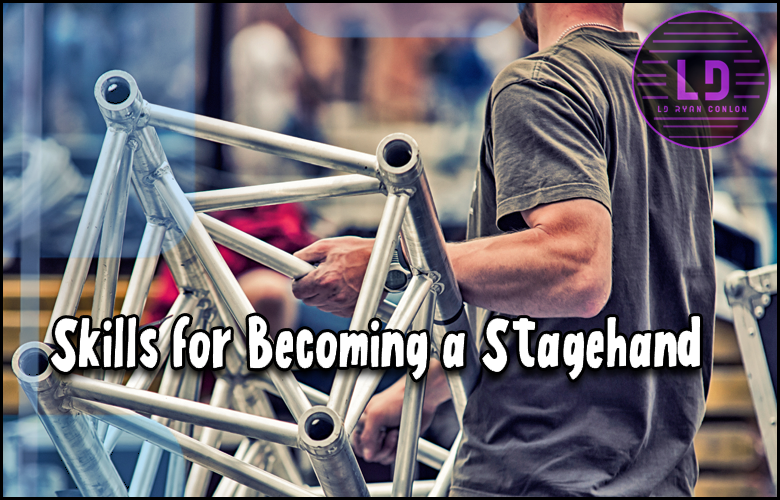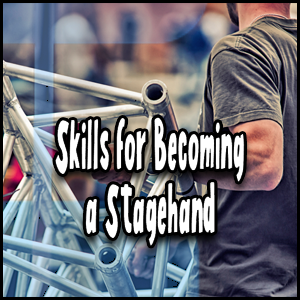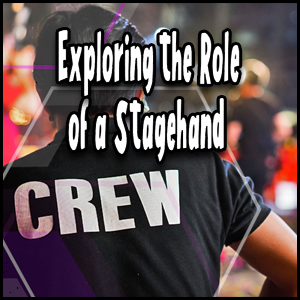
Last Updated on May 12, 2025 by LD Ryan Conlon | 🕒 8 min Read Time
Have you ever wondered about the unsung heroes who turn an empty stage into a living, breathing world filled with color, music, and movement?
Picture this: A master puppeteer deftly operating the strings of a marionette.
Each precise pull is akin to a stagehand’s laborious work that invisibly weaves magic for theater aficionados’ delight–creating majestic sets, managing perfect lighting, and ensuring flawless sound.
Pulling back the curtain on this lesser-known profession, this article will dive deep into what it takes to become a successful professional stagehand – from essential skills to hidden tips only seasoned pros would know.
As you navigate through this piece, you could be setting your first step onto an unseen yet vibrant path waiting backstage!
To become a successful stagehand, it is important to possess a combination of hard and soft skills. Hard skills such as familiarity with venues, audio systems, and stage equipment are crucial. Additionally, soft skills like effective communication, computer proficiency, and manual dexterity are highly valued in this role. These skills enable stagehands to set up lighting, audio, visual, and stage equipment, organize crew members during set-up and break-downs, and assist in the overall production process. Keeping up with safety regulations is also essential.
Understanding the Role of a Stagehand
Welcome to the exciting world of stage production and the essential role of a stagehand!
As a stagehand, you are the backbone of any successful performance.
Your contribution is crucial in creating a seamless and immersive experience for the audience.
So, let’s dive deeper into understanding what it means to be a stagehand and why your role is so valuable.
First and foremost, as a stagehand, you are responsible for ensuring that everything behind the scenes runs smoothly.
You are the unsung hero who works tirelessly to set up and tear down equipment, handle props and scenery, and collaborate with the rest of the production crew.
Think of yourself as a reliable support system for everyone involved in bringing a performance to life.
To illustrate this point, let me share an anecdote.
Imagine attending a theater performance where the lights suddenly flicker or go out completely. The audience is left in darkness, confused and disappointed.
However, moments later, thanks to the swift action of a skilled stagehand, the lights come back on, immediately rekindling the ambiance and keeping the show going seamlessly.
Without that crucial intervention, the performance would have been derailed.
Beyond technical expertise, stagehands often wear many hats – problem solver, quick thinker, and multitasker extraordinaire.
You must adapt to unexpected situations that arise during rehearsals or performances, making split-second decisions to keep everything running smoothly.
It’s like being part of an intricate dance ensemble where each step is crucial for creating a flawless performance.
Now, some might argue that being “behind-the-scenes” means less recognition compared to those in the spotlight.
While it’s true that your contributions may not receive as much applause as those of performers or directors, remember that without your dedication and hard work, their talents wouldn’t shine as brightly.
Ultimately, being an invisible force of brilliance is its own reward, knowing that your efforts have contributed to the success of a show.
To further emphasize the vital role you play as a stagehand, consider the logistical elements involved in any production.
From setting up complex lighting rigs and audio systems to handling intricate stage equipment, each task requires precision and expertise.
It is your responsibility to ensure that all technical aspects are in place, allowing performers to focus on their craft without distractions.
Now that we have discussed the importance of understanding the role of a stagehand, let’s delve into the specific tasks performed by these invaluable members of the production team.
- A study conducted in 2021 reveals that the most sought-after hard skills for stagehands include venues (20.6%), audio systems (11.9%) and stage equipment (9.7%).
- According to a survey from the International Alliance of Theatrical Stage Employees, top soft skills considered essential in this profession are communication, computer skills, and manual dexterity.
- Evidence strongly suggests that specializations such as carpentry and props management can prove advantageous, with approximately 15% of all stagehands possessing experience in these fields.
Tasks Performed by Stagehands
Stagehands perform a wide range of tasks required to keep a live or pre-recorded act running smoothly.
From theaters to concerts, film sets to TV productions, their versatility allows them to adapt to different environments and contribute across various industries.
Let’s explore some of the essential tasks undertaken by stagehands.
One of the primary responsibilities of a stagehand is managing the set.
This includes assembling and disassembling lighting elements, arranging sound equipment, setting up props and scenery, and preparing show signs for clear communication with performers and crew members.
The ability to work efficiently while adhering to safety regulations is paramount.
In live events such as concerts and festivals, stagehands are often involved in organizing and directing crew members during set-up and break-downs.
This includes coordinating with audio technicians, lighting designers, and other production staff to ensure seamless transitions between acts.
It’s like conducting an orchestra behind-the-scenes, where everyone must work together harmoniously.
Imagine attending a music festival where multiple bands perform back-to-back on different stages with minimal downtime between acts.
Efficient stagehands are crucial in swiftly moving equipment and instruments while maintaining a cohesive flow for both performers and audience members alike.
Another essential task performed by stagehands is assisting in the setup and tear-down of audio and video equipment.
This requires proficiency in handling sophisticated technology, understanding signal flow, and working seamlessly with audio and video technicians.
Your contribution ensures that the audience receives the best possible sound and visual experience.
Think of a stage production as a complex puzzle.
Each piece plays a vital role in completing the picture successfully.
Stagehands are responsible for fitting the pieces together, ensuring everything is in its right place.
In doing so, they create an immersive experience, allowing the audience to be transported into another world, whether it’s a captivating play or a high-energy concert.
In addition to technical tasks, stagehands also handle physical elements such as moving heavy equipment, building stages, and operating machinery.
These tasks require physical strength and stamina, making it essential for stagehands to maintain their fitness levels.
You may find yourself meticulously unloading trucks or assembling backline gear with precision – ensuring every instrument is perfectly arranged for the performers.
Now that we have explored the various tasks performed by stagehands let’s move on to discuss the essential technical skills they need to possess.
- Stagehands are indispensable in the entertainment industry, as they perform a diverse range of tasks that keep live or pre-recorded acts running smoothly. Their versatility allows them to contribute across various industries, from theaters to concerts, film sets to TV productions. Some of their fundamental responsibilities include managing the set, organizing crew members during set-up and break-downs, assisting with audio and video equipment setup, and handling physical elements like heavy equipment and stages. Stagehands play a crucial role in creating an immersive experience for the audience and ensuring seamless transitions between acts. They need to possess technical skills such as proficiency in handling sophisticated technology, understanding signal flow, and adhering to safety regulations.
Essential Technical Skills for a Stagehand
As a stagehand, it is crucial to possess a wide range of technical skills that allow you to effectively handle the equipment and machinery necessary to create an unforgettable performance.
These skills not only ensure the smooth operation of shows but also contribute to the overall safety and success of the production.
Let’s delve into some essential technical skills every aspiring stagehand should strive to master.
One indispensable skill for stagehands is the ability to assemble and dismantle lighting rigs efficiently.
Imagine being responsible for setting up a concert venue, where the carefully orchestrated play of lights adds a mesmerizing visual element to the show.
It requires meticulous attention to detail, understanding of different lighting fixtures, knowledge of electrical connections, and how each element contributes to the overall ambiance.
From positioning spotlights to adjusting color filters, your proficiency in lighting can make or break the atmosphere of a performance.
Additionally, familiarity with audio systems is paramount for a stagehand.
Being able to set up sound equipment, configure microphones, and manipulate sound levels requires technical prowess and an acute ear for quality.
Whether it’s providing crystal-clear audio for live concerts or ensuring seamless transitions between cues in theater productions, your expertise in audio management ensures that performers’ voices are heard clearly and that every note rings true.
However, it is important to acknowledge that mastering technical skills doesn’t happen overnight.
Each piece of equipment comes with its own intricacies and quirks that require practice and experience to become proficient.
The learning curve may seem daunting at first, especially when faced with complex cabling systems or advanced software interfaces.
But fear not!
With dedication, hands-on training, and a willingness to continuously learn from more experienced professionals in the field, you can gradually build your repertoire of technical skills.
Think of acquiring technical skills as assembling a tool kit.
Every new skill you learn is like adding a new tool to your arsenal, expanding your capabilities and versatility as a stagehand.
You start with the basics, such as setting up lighting fixtures or operating simple audio systems.
As you gain more experience and broaden your knowledge, you can move on to more advanced tasks like programming lighting consoles or troubleshooting complex sound issues.
Just as a skilled carpenter selects the right tool for each job, you become proficient in selecting and utilizing the appropriate technical skills for every production.
With an understanding of the importance of technical skills in mind, let’s now explore one specific area that is vital for every stagehand’s expertise – handling audio-visual equipment.
Handling Audio-Visual Equipment
In today’s world of live performances and events, audio-visual elements play an integral role in captivating audiences and creating immersive experiences.
As a stagehand, the ability to handle audio-visual equipment effectively is paramount not only for ensuring flawless execution during shows but also for contributing to the overall artistic vision of the performance.
Let’s dive into an example to showcase the significance of this skill. Imagine being part of a team responsible for setting up equipment for a theater production.
The director envisions a grand set with stunning visual projections synchronized with live actors’ performances.
Your role as a stagehand requires not only installing and positioning projectors but also coordinating with video technicians to ensure seamless integration between lighting design, sound effects, and video cues.
By harmoniously aligning these elements, you elevate the audience’s experience and bring the director’s vision to life.
Moreover, many modern concerts rely heavily on large-scale LED screens and other visual displays to immerse the audience in spectacular visuals synchronized with live performances.
Stagehands proficient in handling video equipment are vital in ensuring that all screens are set up correctly, content is seamlessly played back, and timing is on point.
Through your technical expertise, you contribute to the creation of breathtaking visual spectacles that enhance the overall impact of the artist’s performance.
It is essential to recognize the constantly evolving nature of audio-visual technology.
New equipment and software are continuously being introduced to the industry, demanding stagehands to stay updated with these advancements.
Keeping up with technological developments can be challenging, but it also presents opportunities for personal growth and professional advancement.
A curious mindset and a willingness to adapt are crucial traits that will empower you to navigate through the ever-changing landscape of audio-visual equipment.
Handling audio-visual equipment as a stagehand is like being a maestro conducting an orchestra.
Each piece of equipment represents an instrument, and it is your responsibility to orchestrate their synchronization and harmonization.
Just as a conductor guides musicians to play their parts in unison, you guide video technicians, lighting operators, and sound engineers to work together seamlessly.
The result is a symphony of sights and sounds that moves the audience and creates a lasting impression.
Now that we have explored the importance of technical skills, specifically handling audio-visual equipment let’s shift our focus to another crucial aspect: communication and teamwork in the world of stage production.
Mastery of Rigging and Maintenance
One of the essential technical skills that every professional stagehand must possess is the mastery of rigging and maintenance.
This skill set is crucial in ensuring the safety and smooth functioning of stage productions.
Rigging refers to the process of setting up and operating various equipment like lighting fixtures, curtains, and props that are suspended from above the stage.
Maintenance, on the other hand, involves inspecting and repairing equipment to ensure proper functionality.
Let me illustrate this with an anecdote from a seasoned stagehand named Sarah.
Sarah once worked on a large-scale production where she was responsible for rigging the intricate set design.
She had to meticulously plan the placement of each element, considering weight distribution, balance, and the safety of performers who would be moving around on stage.
During one particular rehearsal, Sarah noticed that one of the rigged lights was flickering intermittently.
Realizing that it could pose a safety hazard during the live performance, she immediately halted proceedings and swiftly replaced the faulty bulb.
Her quick thinking and attention to detail ensured a seamless production without any technical mishaps.
The importance of mastering rigging and maintenance cannot be overstated when it comes to stage production.
Rigging requires an understanding of physics, load-bearing capacities, and knowledge of different types of hardware such as shackles, ropes, pulleys, and trusses.
A stagehand must know how to safely suspend heavy equipment from above while considering factors like overhead clearance, audience sightlines, and potential risks associated with vibrations or sudden movements during performances.
Consider the case of a theater company preparing for a musical featuring elaborate flying sequences.
The stagehands responsible for rigging need to meticulously calculate each performer’s weight along with their corresponding harnesses’ load-bearing capacity.
They also have to coordinate with choreographers and directors to ensure smooth transitions between rigged scenes while minimizing any potential risks.
This level of precision and attention to detail is essential to create a visually stunning and safe production.
Some may argue that with advancements in automation and technology, the role of a stagehand in rigging and maintenance is diminishing.
While it’s true that automation has simplified certain tasks, it cannot replace the critical thinking and adaptability of a skilled stagehand.
The ability to troubleshoot technical issues on the spot, make last-minute adjustments, and swiftly respond to unforeseen challenges is invaluable in ensuring the success of any live performance.
Furthermore, automated systems still require human oversight and expertise to ensure proper functioning and mitigate risks.
Think of a stagehand’s mastery of rigging and maintenance as the foundation upon which the entire production rests.
Just like a carpenter needs solid foundations to build a sturdy structure, a stagehand’s skill set ensures that all aspects of a performance come together seamlessly.
It’s like being the architect behind the scenes, meticulously planning every piece of equipment, considering its impact on performers and audience alike.
Communication and Teamwork
Aside from technical expertise, effective communication and teamwork are crucial skills for professional stagehands.
In this fast-paced environment, where numerous professionals collaborate to bring a vision to life, clear lines of communication and harmonious teamwork can make or break a production.
Picture this: It’s show day, moments before curtain call, with the backstage area buzzing with excitement and tension.
In this time-sensitive environment, every member of the stage crew must be in sync to ensure a flawless performance.
The assistant stage manager communicates urgent cues through headset communication systems while stagehands communicate via hand signals in situations where immediate responses are required.
Every team member performs their specific duties while maintaining constant awareness of others’ actions—an intricate dance that relies heavily on seamless communication.
Communication is not just limited to verbal exchanges between crew members but also extends to coordinating with other departments involved in the production.
For instance, stagehands need to communicate regularly with lighting designers, sound engineers, and set designers to ensure proper coordination and synchronization of all elements.
Effective communication ensures that everyone understands their roles and responsibilities and can adapt quickly to last-minute changes.
Imagine a scenario where a stagehand responsible for rigging an aerial silk performance notices that one of the performers feels uncomfortable with the height of the suspended fabric.
In this situation, clear and tactful communication becomes vital.
The stagehand must be able to reassure the performer, listen attentively to their concerns, and work with them and the production team to find a solution.
By fostering open lines of communication built on trust and respect, stagehands contribute to creating a supportive working environment where everyone’s safety and well-being are prioritized.
Some may argue that technical skills overshadow the importance of communication and teamwork in this field.
While technical expertise is undoubtedly crucial, it is essential to recognize that even the most technically skilled stagehand cannot work in isolation.
In an industry where collaboration is at the core, effective communication allows for sharing ideas, troubleshooting challenges collectively, and building camaraderie among crew members.
It fosters a positive work environment that ultimately translates into a better overall production.
Think of communication and teamwork as the glue that holds together the intricate puzzle pieces of a stage production.
Just like a conductor brings harmony through synchronized gestures to an orchestra, effective communication ensures that every member of the production team is aligned towards achieving a common goal—a successful performance that captivates audiences.
The mastery of rigging and maintenance along with strong communication and teamwork skills are indispensable assets for any aspiring professional stagehand.
These two facets intertwine harmoniously in the realm of live performances, ensuring safety, precision, efficiency, and the seamless execution of artistic visions.
In the next sections, we will explore the vital role stagehands play in successful performances and the various ways they contribute to rehearsals and live shows.
Building Synergy with Production Crew
As a stagehand, one of the most crucial skills you must possess is the ability to build synergy with the production crew.
Collaboration and effective communication are essential for a smooth and successful event or performance.
When everyone involved in the production works together seamlessly, it creates an environment where creativity thrives, challenges are overcome, and memorable experiences are created for both performers and audiences alike.
Let’s consider a live concert as an example.
The production crew consists of not only stagehands but also lighting technicians, sound engineers, set designers, and many others.
Each member of this diverse team plays a vital role in bringing the performance to life.
For instance, the lighting technician needs to understand the vision of the set designer to create the right atmosphere on stage.
The sound engineer must work closely with the performers to ensure their audio needs are met.
And as a stagehand, you have your own responsibilities in setting up and striking equipment efficiently while coordinating with others.
Without effective collaboration and communication, chaos can ensue, leading to delays, technical difficulties, and unsatisfied performers or clients.
By building synergy with the production crew, you can mitigate these issues and contribute to a cohesive and well-executed show.
To foster synergy with the production crew, clear channels of communication must exist.
This means actively listening to others’ ideas and concerns while also expressing your own thoughts constructively.
Good communication ensures that everyone understands their roles, responsibilities, and any changes that may occur during the course of the event.
Think of synergy within a production crew as similar to a symphony orchestra.
Each musician has their own instrument but they all work together under the guidance of a conductor to create beautiful music.
Just like musicians must listen to each other and follow cues from their conductor, stagehands must be attentive to instructions from supervisors or production managers and work harmoniously with other crew members.
Now that we understand the importance of building synergy within a production crew, let’s explore further how stagehands contribute to the success of performances.
Role of Stagehands in Successful Performances
Stagehands play a multifaceted role in ensuring the success of performances.
From the initial rehearsals to the final curtain call, their contributions are vital in creating an immersive and flawless experience for both performers and audiences.
During rehearsals, stagehands assist in setting up the stage and all necessary equipment.
They work closely with performers, directors, and other crew members to understand the specific requirements of each scene or act.
This may involve moving props, adjusting lighting fixtures, or building intricate sets.
Without the expertise and attention to detail of stagehands, rehearsals would lack the necessary efficiency to prepare for a seamless performance.
On show days, stagehands ensure that everything runs smoothly behind the scenes.
They coordinate set changes, ensuring that scenery moves seamlessly between scenes without disrupting the flow of the performance.
They handle any last-minute adjustments or repairs needed during intermissions.
Their ability to adapt quickly and solve problems under pressure is crucial to maintaining the momentum and professionalism of the production.
Some may argue that the role of stagehands is merely backstage support and not as glamorous as that of performers.
While it’s true that they may not receive as much public recognition, their impact on the overall experience should not be underestimated.
Just like a well-run machine requires every cog to function flawlessly, a successful performance requires each member of the team, including stagehands, to contribute their best efforts.
Consider a theatrical production as an iceberg.
The audience only sees what happens on stage—the tip of the iceberg—but beneath that surface lies a complex network of systems orchestrated by stagehands.
They ensure that scene changes happen seamlessly, props and costumes are in place, and lighting cues are executed precisely.
Without stagehands, the performance would falter, just as an iceberg would crumble without its solid foundation.
Now that we have explored the vital role of stagehands in successful performances, it is clear that their contributions go far beyond what meets the eye.
In the next section, we will dive deeper into how stagehands can elevate their technical skills to excel in their roles.
Contribution to Rehearsals and Performances
When it comes to the world of live performances, rehearsals are the backbone that ensures a flawless show.
And behind the scenes, stagehands play a vital role in making these rehearsals run smoothly.
Whether it’s a concert, play, or dance performance, stagehands are responsible for setting up and maintaining the technical aspects of the production.
Picture this: it’s the final rehearsal before opening night of a highly anticipated Broadway musical.
The cast is ready to showcase their months of hard work, but without the expertise and dedication of stagehands, their efforts would be in vain.
Stagehands are there early in the morning, ensuring that all lighting fixtures are properly aligned and functioning.
They test and fine-tune audio systems to ensure perfect sound quality throughout the performance.
Every step they take during these crucial moments contributes to creating an immersive experience for both performers and audience members.
Moreover, stagehands are not just responsible for technical setup; they also assist in facilitating smooth transitions between scenes or acts during rehearsals.
They help move set pieces, change props, and adjust stage elements as needed.
Their keen eye for detail allows them to identify any potential issues or hazards before they become major problems during performances.
Stagehands are like silent heroes who operate in the shadows but ensure that every aspect of the production unfolds seamlessly on stage.
Imagine a dance performance where quick scene changes occur multiple times within minutes.
Stagehands have mastered the art of swift transitions during rehearsals, ensuring that sets are precisely moved into place without interrupting the flow of the act.
They work together like a well-rehearsed dance troupe themselves, seamlessly coordinating movements behind the curtain while performers captivate the audience under bright lights.
It’s worth noting that although their contributions to rehearsals may seem invisible compared to performers, stagehands are just as vital to the success of the production.
Some may argue that their work is merely technical and lacks the creativity and emotion that performers bring to the stage.
While it’s true that stagehands generally don’t take center stage, their technical expertise allows performers to shine even brighter.
Without the efforts of stagehands, rehearsals would lack the polish and professionalism necessary to deliver a truly captivating performance.
In a way, stagehands are like the foundation of a house. They provide stability, support, and ensure that everything is in its rightful place.
Just as a strong foundation sets the stage for a beautiful structure, the role of stagehands ensures that performances have a solid base from which actors, singers, and dancers can confidently express themselves.
So next time you’re attending a show, take a moment to appreciate the unsung heroes who work tirelessly behind the scenes: the stagehands.
Their contribution during rehearsals helps set the tone for unforgettable performances that transport us to different worlds and leave us in awe.
Their dedication to their craft is what makes live theater an extraordinary experience for both audience members and performers alike.
Related Posts
- Behind the Curtain: Exploring the World of Stagehands
- How to Get Started as a Stagehand Beginner’s Guide
- What is a Stagehand? Everything You Need to Know
- Union vs Non-Union Stagehand Jobs: Pros and Cons
- Stagehand Tool List | 11 Useful Tools | Always Bring a Crescent Wrench
[scriptless]
Pins for Pinterest
If you like what you see, feel free to share some love on Pinterest ❤️

Ryan Conlon is a highly experienced Corporate Freelance Lighting Designer with two decades of dedicated work in the entertainment industry. With a passion for creating captivating lighting experiences, Ryan has contributed his expertise to numerous corporate meetings, stage productions, concerts, and events throughout his career.








